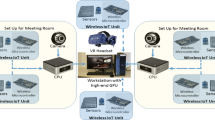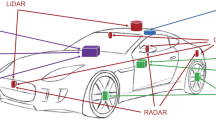Abstract
A ‘smart space’ is one that automatically identifies and tracks its occupants using unobtrusive biometric modalities such as face, gait, and voice in an unconstrained fashion. Information retrieval in a smart space is concerned with the location and movement of people over time. Towards this end, we abstract a smart space by a probabilistic state transition system in which each state records the probabilities of presence of individuals in various zones of the smart space. We carry out track-based reasoning on the states in order to determine more accurately the occupants of the smart space. This leads to a data model based upon an occupancy relation in which time is treated discretely, owing to the discrete nature of events, but probability is treated as a real-valued attribute. Using this data model, we show how to formulate a number of spatio-temporal queries, focusing on the computation of probabilities, an aspect that is novel to this model. We present queries both in SQL syntax and also in CLP(R), a constraint logic programming language (with reals) which facilitates succinct formulation of recursive queries. We show that the answers to certain queries are better displayed in a graphical manner, especially the movement tracks of occupants of the smart space. We also define query-dependent precision and recall metrics in order to quantify how well the model is able to answer various spatio-temporal queries. We show that a query-dependent metric gives significantly better results for a class of occupancy-related queries compared with query-independent metrics.




Similar content being viewed by others
References
Adaikkalavan R, Chakravarthy S (2006) SnoopIB: interval-based event specification and detection for active databases. Data Knowl Eng 59(1):139–165
Agrawal S, Chaudhuri S, Das G, Gionis A (2003) Automated ranking of database query results. In: Proceeding of CIDR ’03, Asilomer, USA
Amicis R, Conti G, Piffer S, Prandi F (2011) Service oriented computing for ambient intelligence to support management of transport infrastructures. J Amb Intell Hum Comput 2(3):201–211
Amoretti M, Copelli S, Wientapper F, Furfari F, Lenzi S, Chessa S (2013) Sensor data fusion for activity monitoring in the PERSONA ambient assisted living project. J Amb Intell Hum Comput 4(1):67–84
Benjelloun O, Sarma AD, Hayworth C, Widom J (2006) An introduction to ULDBs and the trio system. IEEE Data Eng Bull 29(1):5–16
Bohlen MH, Busatto R, Jensen CS (1998) Point-versus interval-based temporal data models. In: Proceeding of 14th international conference on data engineering, pp 192–200
de Caluwe R, deTre G, Bordogna G (2004) Spatio-temporal databases: flexible querying and reasoning. Springer, Berlin
Ceri S, Gottlob G, Tanca L (1989) What you always wanted to know about datalog (and never dared to ask). IEEE Trans Knowl Data Eng 1(1):146–166
Cormode G, Garofalakis M (2007) Sketching probabilistic data streams. In: Proceeding of SIGMOD ’07, pp 281–292
Dalvi N, Re C, Suciu D (2006) Query evaluation on probabilistic databases. IEEE Data Eng Bull 29(1):25–31
Dalvi N, Re C, Suciu D (2009) Probabilistic databases: diamonds in the dirt. Commun ACM 52(7):86–94
Das SK, Cook DJ, Battacharya A, Heierman EO, Lin T (2002) The role of prediction algorithms in the MavHome smart home architecture. IEEE Wirel Commun 9(6):77–84
Demers AJ, Gehrke J, Hong M, Riedewald M, White WM (2006) Towards expressive publish/subscribe systems. In: Proceeding of 10th international conference on extending database technology (EBDT ’06), pp 627–644
Deshpande A, Guestrin C, Madden S, Hellerstein JM, Hong W (2004) Model-driven data acquisition in sensor networks. In: Proceeding of VLDB ’04, pp 588–599
Guting R, Schneider M (2005) Moving object databases. Morgan Kaufmann
Jaffar J, Michaylov S, Stuckey P, Yap R (1992) The CLP(R) Language and system. ACM Trans Program Lang Syst (TOPLAS) 14(3):339–395
Jayram TS, Kale S, Vee E (2007) Efficient aggregation algorithms for probabilistic data. In: Proceeding of symposium on discrete algorithm (SODA ’07), pp 346–355
McCarthy JF, Anagnost TD (2000) EVENTMANAGER: support for the peripheral awareness of events. In: Proceeding of 2nd international conference on handheld and ubiquitous computing (HUC ’00), pp 67–96
Menon V, Jayaraman B, Govindaraju V (2008) Biometrics driven smart environments: abstract framework and evaluation. In: Proceeding of 5th international conference on ubiquitous intelligence and computing (UIC-08), Springer-Verlag, London, pp 75–89
Menon V, Jayaraman B, Govindaraju V (2010) Multimodal identification and tracking in smart environments. J Pers Ub Comput 14(8):685–694
Menon V, Jayaraman B, Govindaraju V (2011) The three Rs of cyberphysical spaces. Comput Aided Des 44(9):73–79
Menon V, Jayaraman B, Govindaraju V (2012a) Enhancing biometric recognition with spatio-temporal reasoning in smart environments. J Pers Ub Comput. doi:10.1007/s00779-012-0546-x
Menon V, Jayaraman B, Govindaraju V (2012b) Spatio-temporal querying in smart spaces. In: Proceeding of 3rd international conference on ambient systems, networks and technologies (ANT-2012), Elsevier Science, pp 366–373
Motro A (1988) Vague: a user interface to relational databases that permits vague queries. ACM Trans Inf Syst 6(3):187–214
Papandrea M, Giordano S (2013) Location prediction and mobility modelling for enhanced localization solution. J Amb Intell Hum Comput. doi:10.1007/s12652-013-0175-x
Pelekis N, Frentzos E, Giatrakos N, Theodoridis Y (2008) HERMES: aggregative LBS via a trajectory DB engine. In: Proceeding of 28th international conference on management of data (SIGMOD 08), ACM, Canada
Re C, Suciu D (2007) Materialized views in probabilistic databases for information exchange and query optimization. In: Proceeding of VLDB ’07, pp 51–62
Re C, Dalvi N, Suciu D (2007) Efficient top-k query evaluation on probabilistic data. In: Proceeding of ICDE ’07, pp 886–895
Re C, Letchner J, Balazinksa M, Suciu D (2008) Event queries on correlated probabilistic streams. In: Proceeding of ACM SIGMOD international conference on management of data, pp 715–728
Snodgrass R (1987) The temporal query language TQuel. ACM Trans Database Syst 12(2):247–298
Toman D (1996) Point vs. interval-based query languages for temporal databases. In: Proceeding of 15th ACM SIGACT-SIGMOD-SIGART symposium on principles of database systems (PODS), pp 58–67
Wu E, Diao Y, Rizvi S (2006) High-performance complex event processing over streams. In: Proceeding of ACM SIGMOD’ 06, pp 407–418
Author information
Authors and Affiliations
Corresponding author
Rights and permissions
About this article
Cite this article
Menon, V., Jayaraman, B. & Govindaraju, V. Probabilistic spatio-temporal retrieval in smart spaces. J Ambient Intell Human Comput 5, 383–392 (2014). https://doi.org/10.1007/s12652-013-0199-2
Received:
Accepted:
Published:
Issue Date:
DOI: https://doi.org/10.1007/s12652-013-0199-2




